12th Economics Chapter 6 Solutions (Index Numbers) Maharashtra Board – Free Solution
Table of Contents
12th Economics Chapter 6 Solutions

Chapter 6 – Index Numbers
Q. 1. Choose the correct option
1) Statements that are incorrect in relation to index numbers.
a) Index number is a geographical tool.
b) Index numbers measure changes in the air pressure.
c) Index numbers measure relative changes in an economic variable.
d) Index numbers are specialized averages.
Options :
1) c and d
2) a and b
3) b and c
4) a and d
2) Statements that highlight the significance of index numbers.
a) Index numbers are useful for making future predictions.
b) Index numbers help in the measurement of inflation.
c) Index numbers help to frame suitable policies.
d) Index numbers can be misused.
Options :
1) b, c and d
2) a, c and d
3) a, b and d
4) a, b and c
3) Statements that apply to weighted index numbers.
a) Every commodity is given equal importance.
b) It assigns suitable ‘weights’ to various commodities.
c) In most of the cases, quantities are used as weights.
d) Laaspeyre’s and Paasche’s method is used in the calculation of weighted index numbers.
Options :
1) b, c and d
2) a, c and d
3) a, b and d
4) a, b, c and d
4) Statements related to limitations of index numbers.
a) Index numbers are not completely reliable.
b) There may be a bias in the data collected.
c) Every formula has some kind of defect.
d) Index numbers ignore changes in the qualities of products.
Options :
1) a, c and d
2) a, b, c and d
3) a, b and d
4) b, c and d
5) Choose the correct pair :
| Group A | Group B |
| 1) Price Index | a) Σp1q1 / Σp0q0 × 100 |
| 2) Value Index | b) Σq1 / Σq0 × 100 |
| 3) Quantity Index | a) Σp1q1 / Σp0q1 × 100 |
| 4) Paasche’s Index | a) Σp1 / Σp0 × 100 |
Options :
1) 1-d, 2-c, 3-a, 4-b
2) 1-d, 2-a, 3-b, 4-c
3) 1-b, 2-c, 3-d, 4-a
4) 1-c, 2-d, 3-a, 4-b
Q. 2. Complete the Correlation
1) Price Index : Inflation : : Agricultural productivity index : Agricultural production
2) p0 : Base year prices : : p1 : Current year prices
3) Laaspeyre’s index : Base year quantities : : Paasche’s index : Current year quantities
4) Univariate index : Single variable : : Composite index : Group of variables
Q. 3. Solve the following
1) Calculate Price Index number from the given data:
| Commodity | A | B | C | D |
| Price in 2005 (Rs) | 6 | 16 | 24 | 4 |
| Price in 2010 (Rs) | 8 | 18 | 28 | 6 |
Solution:
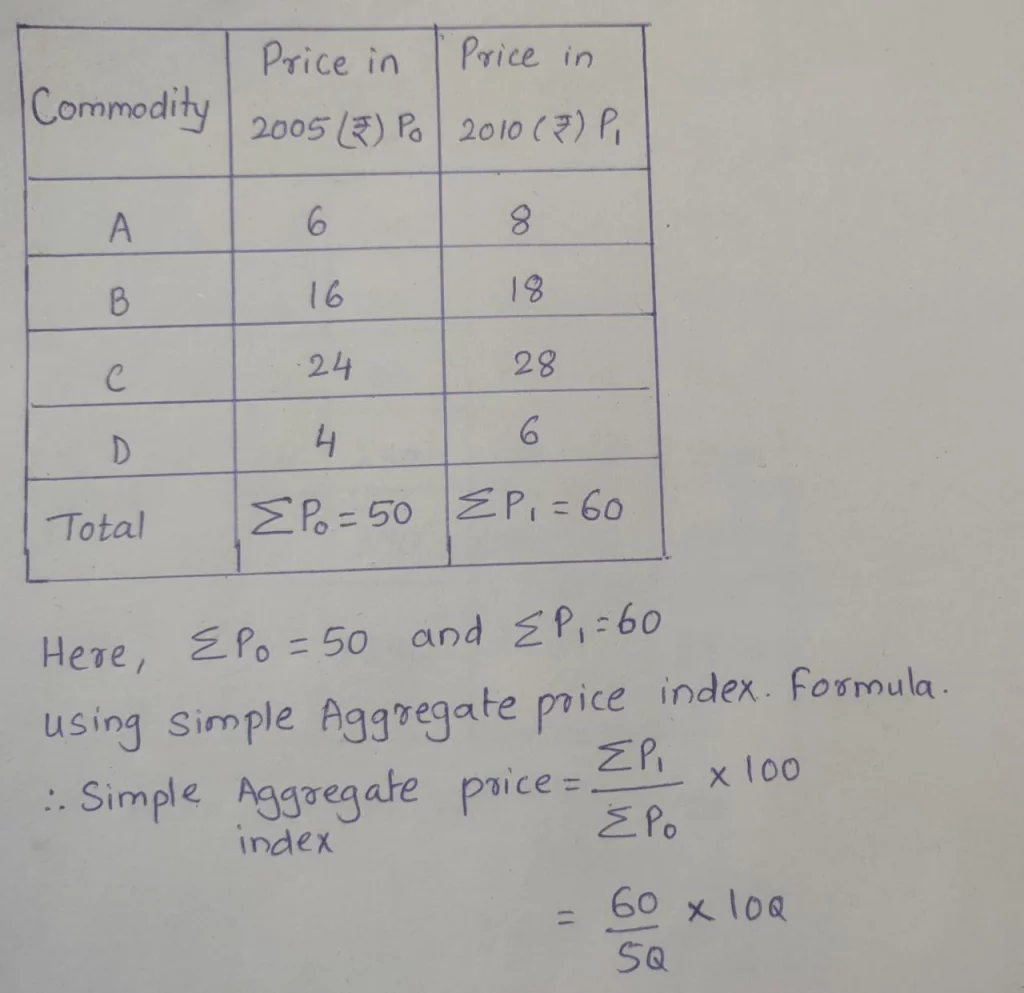
2) Calculate Quantity Index number from the given data :
| Commodity | P | Q | R | S | T |
| Base year quantities | 170 | 150 | 100 | 195 | 205 |
| Current year quantities | 90 | 70 | 75 | 150 | 95 |
Solution:
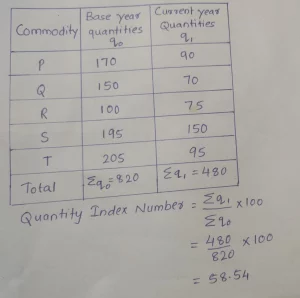
3) Calculate Value Index number from the given data :
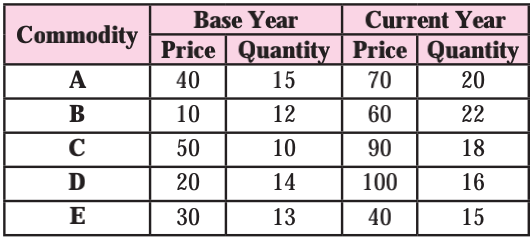
Solution:
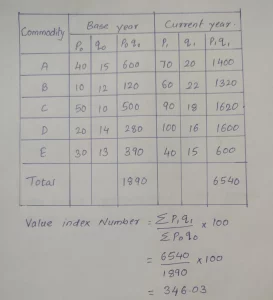
4) Calculate Laaspeyre’s and Paasche’s index from the given data :

Solution:
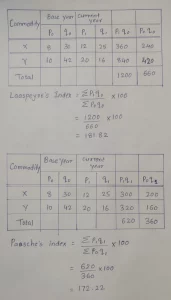
Solution of other subjects
Solution of all the Chapters of Economics
1 – 2 – 3A – 3B – 4 – 5 – 6 – 7 – 8 – 9 – 10
Q. 4. Distinguish between
1) Simple Index Numbers and Weighted Index Numbers.
| Points | Simple Index Numbers | Weighted Index Numbers |
| 1) Meaning | In this method, every commodity is given equal importance. | In this method, suitable weights are assigned to various commodities. It gives relative importance to the commodity in the group. |
| 2) Nature | It is the easiest method of constructing index numbers. | It is a comparatively complex method of constructing index numbers. |
| 3) Application | This method can be applied to determine 1) Price Index Number 2) Quantity Index Number 3) Value Index Number | There are various methods of constructing weighted index numbers such as Laaspeyre’s Price Index, Paasche’s Price Index etc. |
2) Price Index and Quantity Index.
| Points | Price Index | Quantity Index |
| 1) Meaning | It measures the general changes in the prices of goods. It compares the level of prices between two different time periods. | It is also called volume index number. It measures changes in the level of output or physical volume of production in the economy. |
| 2) Formula | P01 = Σp1 / Σp0 × 100 | Q01 = Σq1 / q0 × 100 |
3) Laaspeyre’s Index and Paasche’s Index.
| Points | Laaspeyre’s Index | Paasche’s Index |
| 1)Meaning | In this technique, ‘base year’ quantities are considered as weights. | In this technique, quantities of the ‘current year’ are considered as weights. |
| 2) Formula | Laaspeyre’s Index is calculated as P01 = Σp1q0 / Σp0q0 × 100 | Paasche’s Index is calculated as P01 = Σp1q1 / Σp0q1 × 100 |
Q.5. State with reasons whether you agree or disagree with the following statement
1) Index numbers measure changes in the price level only.
Ans: No, I disagree with this statement.
Reason:
a) An index number is a device to measure changes in an economic variable (or group of variables) over a period of time.
b) Index numbers were originally developed to measure changes in the price level.
c) In the present context, it is also used to measure trends in a wide variety of areas that includes stock market
prices, cost of living, industrial and agricultural production, changes in exports and imports etc.
d) Hence, Index numbers do not measure changes in the price level only, but also measure changes in many other economic variables.
2) Index numbers are free from limitations.
Ans: No, I disagree with this statement.
Reason:
a) Index numbers are generally based on samples. We cannot include all the items in the construction of the index numbers. Hence they are not free from sampling errors.
b) Index numbers are constructed on the basis of various types of data which may be incomplete.
c) They compare a situation in the current year with a situation in the base year. Hence a person may choose a base year that will be suitable for his purpose.
d) Therefore, Index numbers are not free from limitations.
3) Index numbers can be constructed without the base year.
Ans: No, I disagree with this statement.
Reason:
a) An index number is a device to measure changes in an economic variable over a period of time.
b) Base year is the year against which comparisons are made.
c) Base year is also called the reference year. The base year should be normal i.e. it should be free from natural calamities. It should not be too distant in the past.
d) Therefore, Index numbers cannot be constructed without the base year.
Solution of other subjects
Solution of all the Chapters of Economics
1 – 2 – 3A – 3B – 4 – 5 – 6 – 7 – 8 – 9 – 10
Q.6. Answer the following
1) Explain the features of index numbers.
Answer: Index Numbers are devices for measuring differences in the magnitude of a group of related variables.”
Features of Index Numbers:
- Index numbers are statistical devices.
- Index numbers are specialized averages that are capable of being expressed in percentages.
- Index numbers measure the net change in one or more related variables over a period of time or between two different time periods or two different localities.
- Index number which is computed from a single variable is called a ‘univariate index’, whereas an index that is constructed from a group of variables is called a ‘composite index’.
- The year for which the index number is prepared is the current year.
- The year with which the changes are measured is called the base year.
- The base year’s index is assumed as 100 and accordingly, the value of the current year is calculated.
- Index numbers are also referred to as barometers of economic activity since it is used to measure the trends and changes in the economy.
2) Explain the significance of index numbers in economics.
.Answer: Index numbers are indispensable tools of economic analysis.
The following points explain the significance of index numbers:
1) Framing suitable policies:
Index numbers provide guidelines to policy makers in framing suitable economic policies such as agricultural policy, industrial policy, fixation of wages and dearness allowances in accordance with the cost of living etc.
2) Studies trends and tendencies:
Index numbers are widely used to measure changes in economic variables such as production, prices, exports, imports etc. over a period of time.
3) Forecasting about future economic activity:
Index numbers are useful for making predictions for the future based on the analysis of the past and present trends in economic activities. For example, based on the available data pertaining to imports and exports, future predictions can be made.
4) Measurement of inflation:
Index numbers are also used to measure changes in the price level from time to time. It enables the government to undertake appropriate anti-inflationary measures.
5) Useful to present financial data in real terms:
Deflating means making adjustments in the original data. Index numbers are used to adjust price changes, wage changes, etc. Thus, deflating helps to present financial data in real terms (at constant prices).
Solution of other subjects
Solution of all the Chapters of Economics
1 – 2 – 3A – 3B – 4 – 5 – 6 – 7 – 8 – 9 – 10
Q.7. Answer in detail
1) Explain the steps involved in the construction of index numbers.
Answer: An index number is a device to measure changes in an economic variable (or group of variables) over a period of time. Index numbers were originally developed to measure changes in the price level.
The following steps are involved in the construction of index numbers :
1) Purpose of index number:
The purpose for constructing the index number, its scope as well as which variable is intended to be measured should be clearly decided to achieve fruitful results.
2) Selection of the base year:
The base year is also called the reference year. It is the year against which comparisons are made. The base year should be normal i.e. it should be free from natural calamities. It should not be too distant in the past.
3) Selection of items:
It is necessary to select a sample of the number of items to be included in the construction of a particular index
number. For example, in the construction of price index numbers, it is impossible to include each and every commodity. The commodities to be selected should represent the tastes, habits and customs of the people. Besides this, only standardized or graded items should be included to give better results.
4) Selection of price quotations:
Prices of the selected commodities may vary from place to place and shop to shop in the same market. Therefore, it is desirable that price quotations should be obtained from an unbiased price reporting agency. To achieve accuracy, a proper selection of representative places and persons is required.
5) Choice of a suitable average:
The construction of index numbers requires a choice of a suitable average. Generally, the Arithmetic mean is used in the construction of index numbers because it is simple to compute compared to other averages.
6) Assigning proper weights:
Weight refers to the relative importance of the different items in the construction of an index number. Weights are of two types i.e. quantity weights (q) and value weights (p x q). Since all items are not of equal importance, by assigning specific weights, better results can be achieved.
7) Selection of an appropriate formula:
Various formulae are devised for the construction of index numbers. The choice of a suitable formula depends upon the purpose of index number and availability of data.
Extra Questions
Answer the following questions.
Solution of other subjects
Solution of all the Chapters of Economics
1 – 2 – 3A – 3B – 4 – 5 – 6 – 7 – 8 – 9 – 10

![12th BK Paper Pattern 2023-24 | Maharashtra Board [Download Free PDF] 16 BK Paper Pattern 2023](https://scholarsclasses.com/blog/wp-content/uploads/2023/10/Screenshot-2023-10-23-at-3.20.20-PM-520x245.png)
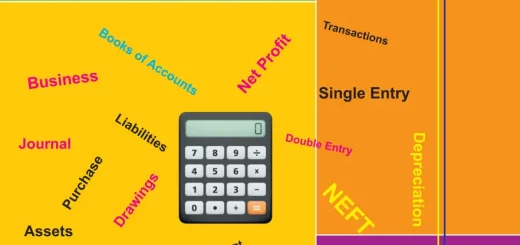
Very nice and useful app